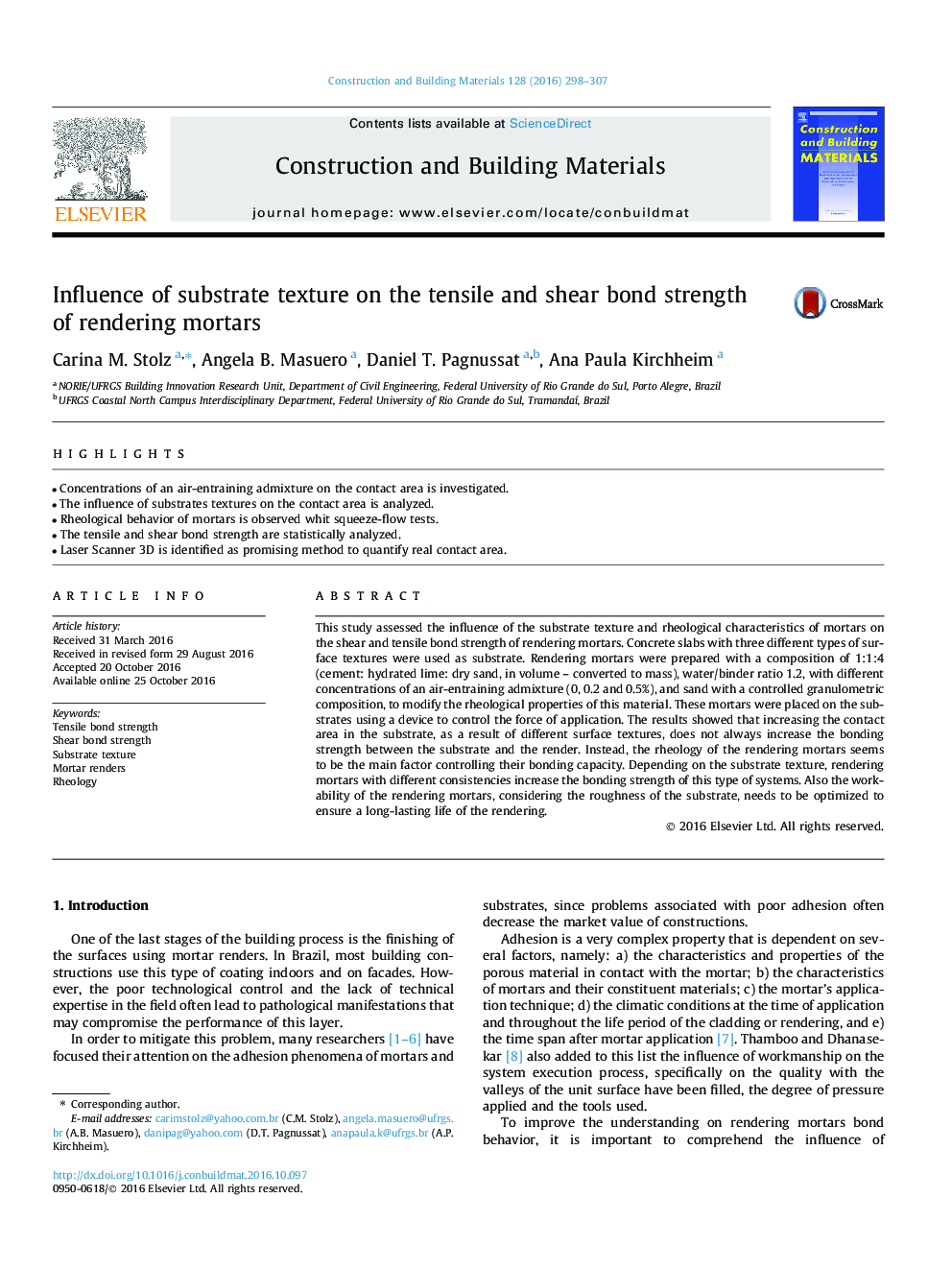| کد مقاله | کد نشریه | سال انتشار | مقاله انگلیسی | نسخه تمام متن |
|---|---|---|---|---|
| 4914044 | 1428778 | 2016 | 10 صفحه PDF | دانلود رایگان |
عنوان انگلیسی مقاله ISI
Influence of substrate texture on the tensile and shear bond strength of rendering mortars
ترجمه فارسی عنوان
تاثیر بافت سوبسترا بر استحکام باند کششی و برشی خمپاره ها
دانلود مقاله + سفارش ترجمه
دانلود مقاله ISI انگلیسی
رایگان برای ایرانیان
کلمات کلیدی
استحکام باند کششی، استحکام باند برشی، بافت پایه، ملات رندر، رئوئولوژی،
ترجمه چکیده
در این تحقیق تأثیر بافت سوبسترا و خصوصیات رئولوژیکی ملات بر مقاومت برشی و استحکام کششی ملات های رندر بررسی شد. اسلب بتنی با سه نوع بافت سطحی متفاوت به عنوان بستر استفاده می شود. خمیر های ارائه دهنده با ترکیب 1: 1: 4 (سیمان: آهک هیدراته: شن و ماسه خشک، حجم - تبدیل به جرم)، نسبت آب / اتصال دهنده 1،2، با غلظت های متفاوت از یک مخلوط هوادهی (0، 0.2 و 0.5٪) و ماسه با یک ترکیب گرانولومتری کنترل شده برای تغییر خواص رئولوژیکی این ماده. این خمپاره ها بر روی بسترها قرار گرفتند و با استفاده از یک دستگاه برای کنترل نیروی کاربرد قرار می گرفتند. نتایج نشان داد که افزایش سطح تماس در بستر، به عنوان یک نتیجه از بافت های مختلف سطحی، همیشه باعث افزایش قدرت پیوند بین بستر و رندر می شود. به نظر می رسد رولوژی خمپاره های رندر عامل اصلی کنترل ظرفیت پیوند آنهاست. با توجه به بافت بستر، ارائه ملات با سازگاری های مختلف باعث افزایش قدرت پیوند این نوع سیستم ها می شود. همچنین کارایی خمپاره های رندرینگ، با توجه به زبری بودن بستر، باید برای اطمینان از عمر طولانی رندر، بهینه سازی شود.
موضوعات مرتبط
مهندسی و علوم پایه
سایر رشته های مهندسی
مهندسی عمران و سازه
چکیده انگلیسی
This study assessed the influence of the substrate texture and rheological characteristics of mortars on the shear and tensile bond strength of rendering mortars. Concrete slabs with three different types of surface textures were used as substrate. Rendering mortars were prepared with a composition of 1:1:4 (cement: hydrated lime: dry sand, in volume - converted to mass), water/binder ratio 1.2, with different concentrations of an air-entraining admixture (0, 0.2 and 0.5%), and sand with a controlled granulometric composition, to modify the rheological properties of this material. These mortars were placed on the substrates using a device to control the force of application. The results showed that increasing the contact area in the substrate, as a result of different surface textures, does not always increase the bonding strength between the substrate and the render. Instead, the rheology of the rendering mortars seems to be the main factor controlling their bonding capacity. Depending on the substrate texture, rendering mortars with different consistencies increase the bonding strength of this type of systems. Also the workability of the rendering mortars, considering the roughness of the substrate, needs to be optimized to ensure a long-lasting life of the rendering.
ناشر
Database: Elsevier - ScienceDirect (ساینس دایرکت)
Journal: Construction and Building Materials - Volume 128, 15 December 2016, Pages 298-307
Journal: Construction and Building Materials - Volume 128, 15 December 2016, Pages 298-307
نویسندگان
Carina M. Stolz, Angela B. Masuero, Daniel T. Pagnussat, Ana Paula Kirchheim,
